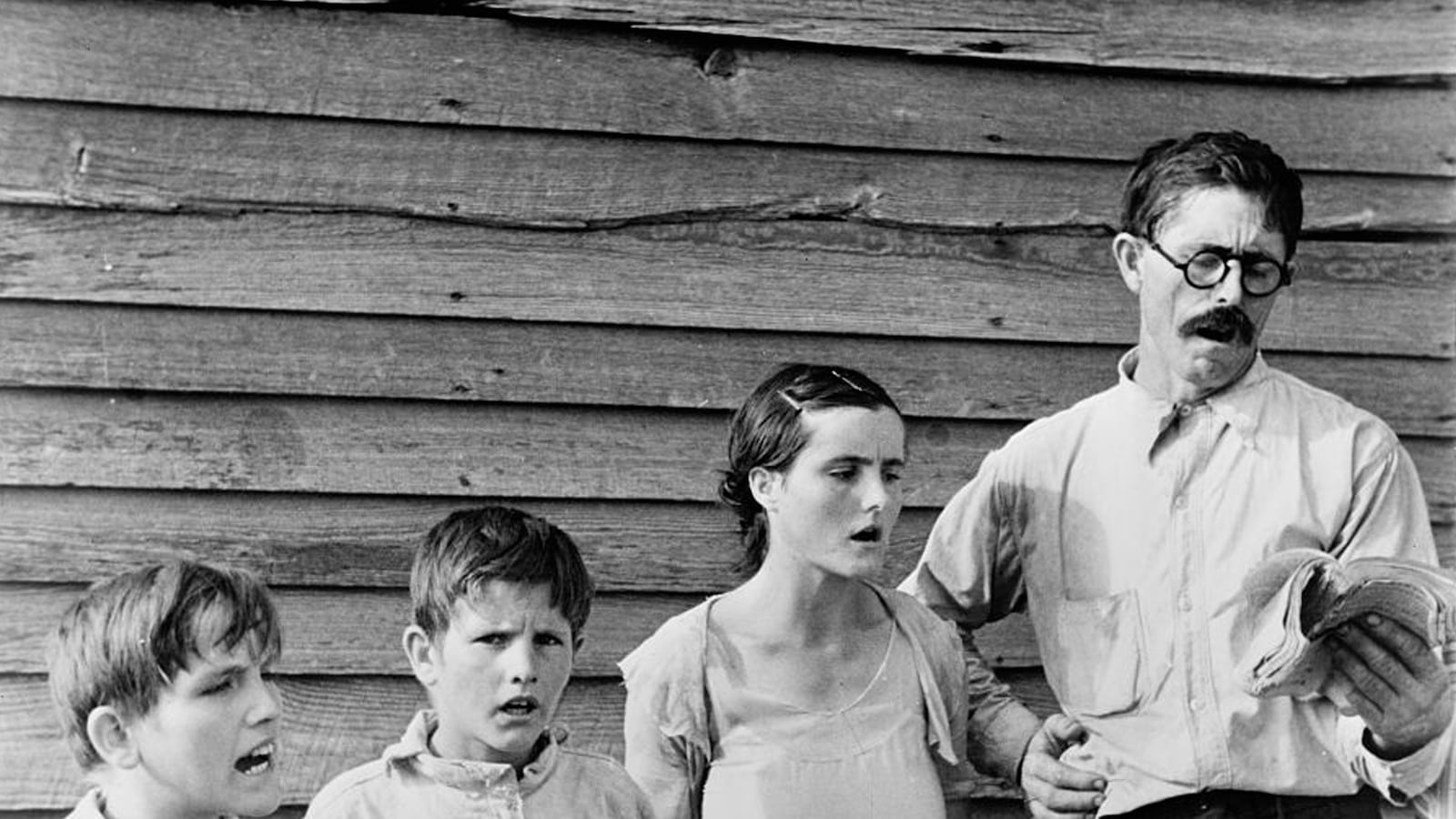If, like me, you were at some point in your life addicted to the work of James Agee, then your pulse must have raced a little when you heard the news recently that the original version of Let Us Now Praise Famous Men had at long last come to light.

Agee and the photographer Walker Evans traveled to Alabama in 1936 and spent much of that summer with three tenant farming families at the behest of Fortune magazine, where Agee was a staff writer. (Evans was at that time working as a photographer for the federal government and got a leave of absence to travel with Agee, which explains why a lot of the pictures he took on that trip later wound up as part of the Farm Security Administration archive in the Library of Congress.) The Fortune story never ran, but Agee kept working on the project, and in 1941 he and Evans published Let Us Now Praise Famous Men, a much enlarged and vastly more ambitious work that has over time become a classic if unclassifiable piece of American literature.
When Agee chose his book’s title from a passage in the Apocrypha, he was being ironic, since his subjects—Alabama tenant farmers—were not only not famous but ignored, neglected, marginalized, and scorned by the rest of the nation. But sometimes irony breeds upon itself, and this is one of those instances. Agee and Evans’s book only sold around 600 copies when it appeared in 1941, but over time it has established itself as a unique and enduring mashup of reporting, confession, and oracular prose that sometimes takes your breath away. In the process, the three families portrayed by Agee and Evans have indeed achieved not fame exactly but certainly a sort of iconic immortality. Along with the Depression victims photographed by Dorothea Lange, Russell Lee, and the other photographers working for the Farm Security Administration, they are who and what we think of when we call that era to mind.
I’ve worn out three copies, and I doubt my affection for this strange book is all that unique. I have also changed my mind about it as many times as I have read it. As a young man, I was completely under its spell. As the years past and my tastes changed, I came to hold it in a chillier regard, and there were times when I considered it one of the most self-indulgent train wrecks in the history of literature, worth saving only for Evans’s indelible photographs. To be fair, any prose would suffer in close comparison with those images, which look like nothing so much as something handed down by God. Rereading it now, I still find much of it hard to take, rather like a chocolate cake made entirely of icing. But when Agee stops going cosmic on you and gets down to describing the rudiments and fixtures of the lives of the farming families, it becomes an altogether different book—profound, illuminating, and unforgettable. I was shocked, this time around, to discover how many passages I had virtually committed to memory.
There might seem to be little left to learn about this oddball masterpiece. But recently archivists discovered among Agee’s papers the original 30,000-word story that he wrote for Fortune. Much shorter and a lot less ambitious than what would eventually become Let Us Now Praise Famous Men, the manuscript, published jointly by The Baffler and Melville House as Cotton Tenants: Three Families, sheds considerable light on the origins of a classic. It may not be the Rosetta Stone, but it gives us at least a Point A from which we may gauge how far Agee traveled to create his finished book.
The early draft is mainly a sketch for the last two-thirds of Agee’s ultimate text, the part devoted to a minute dissection of various aspects of tenant life, including money, shelter, clothing, education, and work. As a magazine feature, it fails by any conventional standard, and failed by Agee’s standards as well, apparently. “The trip was very hard, and certainly one of the best things I’ve ever had happen to me,” he wrote to a friend after he returned to New York in the fall of 1936. “Writing what we found is a different matter. Impossible in any form and length Fortune can use; and I am now so stultified trying to do that, that I’m afraid I’ve lost ability to make it right in my own way.” Maybe a gentler way to say the same thing is that Agee fails almost completely as a conventional magazine writer. But when he relaxes a bit, and stops trying to be conventional and cooking his prose into something biblical—in other words, when he settles for being James Agee, a Southern boy with a poet’s eyes and tongue—he does fine.
Describing the frail nature of the outbuildings on one farm, he writes with economy and dry humor, “These buildings could all but be pushed flat by one man who tried hard.” Of one farmer’s mother in law, he says, “She is the sort of woman the children of nice people shout after in the street.”

But the most fascinating sections are the germinal passages upon which Agee would build and elaborate in the final version. In Cotton Tenants, there is a quick, vivid image of the spring that supplies water for one family: “The spring is not so deeply cowled beneath the hill that the water is cold and nervy: it is about the temper of faucet water, and it tastes sad on the mouth.” The same section in Let Us Now Praise Famous Men is not more poetic. But it is rounder, more complete: “The spring is not cowled so deeply under the hill that the water is brilliant and nervy, seeming to break in the mouth like crystals, as spring water can: it is about the temper of faucet water, and tastes slack and faintly sad, as if just short of stale. It is not quite tepid, however, and it does not seem to taste of sweat and sickness, as the water does which the Woods family have to use.” When you read these passages back to back, it’s like watching an artist turn a sketch into a painting. Cotton Tenants may be no masterpiece, but it is an invaluable addition to the Agee shelf.
Agee’s prose is germinal in another way. Artistically speaking, few places in the United States have been more pawed over than Hale County, Alabama, or fired more imaginations. Since the first publication of Let Us Now Praise Famous Men, its inspiration for other artists has been both broad and deep. The book directly inspired Aaron Copland’s opera The Tender Land. And more recently, writer Dale Maharidge and photographer Michael Williamson revisited the subjects of the original book 50 years later in And Their Children After Them. That book, extraordinary in its own way, won a Pulitzer Prize. The practitioners of the New Journalism in the ‘60s and ‘70s all owed Agee a huge debt, and Evans’s photos have by now influenced several generations of documentarians.

Let Us Now Praise Famous Men also profoundly shaped the photographer William Christenberry, a Hale County native who grew up near the subjects portrayed by Agee and Evans and whose own family knew some of the people in the book. (Coincidentally, Christenberry was born the same year Agee and Evans made their trip to Alabama.) In the ‘60s, Christenberry met Evans, who became an enduring influence. But long before that, he has said, the book taught him that there was artistic possibility in his own backyard.
For decades, long after he moved away from home, Christenberry returned each summer to photograph the changing landscape of his native soil. Now when I look at his work, which obsessively records the passage of time and its effects on people and places in the landscape, I think of a passage in which Agee describes one of the rickety houses inhabited by a tenant family: “A hollow altar, temple, or poor shrine, a human shelter, which for the space of a number of seasons shall hold this shape of earth denatured: yet in whose history this house shall have passed soft and casually as a snowflake fallen on black spring ground, which thaws in touching.” Agee and Evans recognized that art and memory conjoined are the only true bulwarks against the obliteration of all we hold dear about the past.





